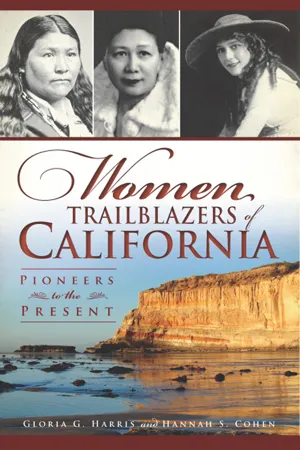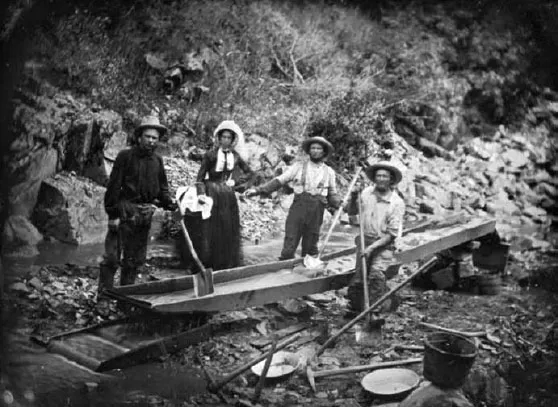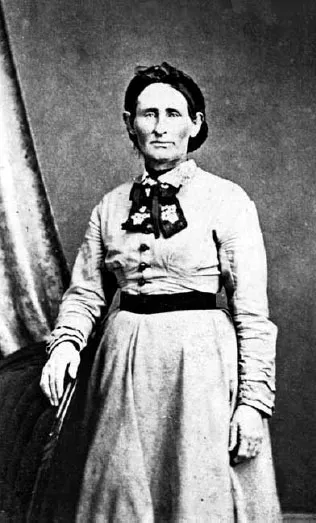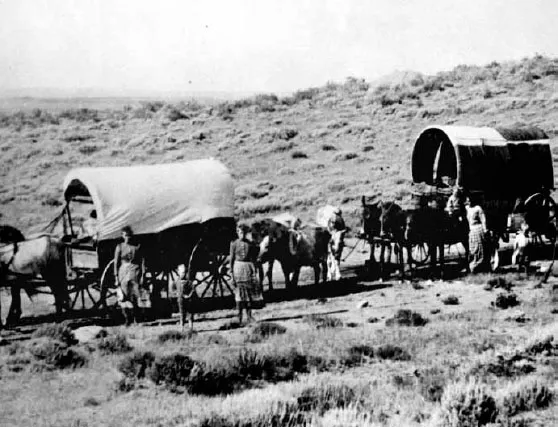![]()
PART I
Women of Early California
![]()
Chapter 1
PIONEERS
In the year 1510, Spanish author Garcia de Montalvo wrote Las Sergas de Esplandian (The Deeds of Esplandian), an epic novel about Spanish chivalry. One of the fictional characters in the popular story was Queen Calafia, the courageous leader of a race of black Amazons. In the book, she is described as the most beautiful of a long line of queens who ruled over California, a mythical island. Calafia and her women warriors were said to wear gold armor adorned with many precious stones.
“At the right hand of the Indies very near the location of the Garden of Eden, there once was an island called California, which was inhabited by black women without any man being among them, so that their way of life was almost Amazon like,” the popular tale began. “They had strong bodies and valiant, fervent hearts and had great courage.”
De Montalvo’s romantic tale captured the imagination of future explorers of the New World who hoped to discover a nation of women and riches. Twelve years after the novel was published, a party of Spanish explorers sent by Hernan Cortes anchored their ships on what appeared to be an island off western Mexico in the recently discovered Pacific Ocean. Elated that they had found the mythical island described in de Montalvo’s story, the place was named “California.” Given the exciting details of de Montalvo’s tale, it was an understandable mistake to believe that Baja California, a peninsula, was the fictional island ruled by the beautiful warrior queen Calafia.
The actual discoverer of California, Juan Rodriguez Cabrillo, arrived in the future harbor of San Diego in 1542. Despite the legend of black Amazon queens, the Spanish made no effort to colonize the area until the eighteenth century. In preparation for settlement, the mainland region of California was granted to Franciscan missionaries in order to convert the native population to Catholicism. Between 1769 and 1823, Spanish friars established twenty-one missions, each a day’s journey from the next, along the Pacific coastline. The first one was established by Father Serra in San Diego in 1769.
In Auburn Ravine. Courtesy of the California History Room, California State Library.
At the end of the eighteenth century, Spain experienced a series of international difficulties, and in 1822, the tattered flag of Spain was lowered for the last time at Monterey and the new banner of Mexico was raised in its place. In 1848, the Treaty of Guadalupe Hidalgo ended the Mexican-American War and resulted in Mexico ceding California to the United States. It was not until the 1840s that American families began heading west.
The 1848 discovery of gold on the American River in Northern California forever changed the state’s history. When news of gold spread around the world, thousands of prospectors, dreaming they would strike it rich, traveled to the newly conquered territory. The sudden arrival of nationalities, races and ethnicities in one region was unprecedented in U.S. history. Until the mid-1850s, most women stayed behind, and the perilous overland journey to California was undertaken primarily by adventurous young men. The gold-mining camps were viewed as unsafe for women, and female pioneers were in scarce supply.
This chapter tells the remarkable stories of Nancy Kelsey, a young pioneer who was the first white woman to travel to California; Luzena Wilson, an entrepreneurial frontier woman; Mary Ellen Pleasant, a black civil rights crusader; and Charlotte “Charley” Parkhurst, a strong, independent woman who courageously defied her gender’s identity.
NANCY KELSEY (1823–1896)
FIRST WOMAN TO TRAVEL OVERLAND TO CALIFORNIA
Nancy Kelsey was born in Kentucky in 1823, a few miles from the Missouri River that was the border of the settled United States. At the age of fifteen, she married a man twelve years her senior. During the 1840s, American families began heading for California to seek a better life, and her husband was a man with ambitious plans for their future. In 1841, the Kelseys and their infant daughter began a wagon train journey across the country that no white woman had ever made. Kelsey explained her reason for making the trip: “Where my husband goes I can go. I can better stand the hardships of the journey than the anxieties for an absent husband.”
Nancy Kelsey. Courtesy of the California History Room, California State Library.
In 1841, several Missourians received a letter from Dr. John Marsh praising California. In it he described “a wonderful fertile land with a sublime climate, meek Indians, and a lax local Mexican government.” Paradise was located by the Pacific, waiting to be visited by enterprising people. One of the people who received the letter was a local farmer, John Bartleson, who passed the word on to the newspapers. After Kelsey read the letter to her husband, he became determined to join a group bound for the West Coast organized by John Bidwell.
Preparations for the trip included two farm wagons with wooden beds about ten feet long by four feet wide, sloping sides and a canvas cover that could be drawn closed to protect them from the rain. The wagons were to be pulled by oxen while Kelsey and her husband would ride their horses. John Bartleson, a man who had traveled farther west than the others, was chosen to be the party’s leader. The group consisting of the Kelsey family and about thirty men departed from Missouri in the spring of 1841. They became known as the Bidwell-Bartleson party.
For the first twelve hundred miles, the group followed the Oregon Trail and all went well, but the party was ill prepared for the challenges that lay ahead. Members of the group had limited knowledge of western geography and lacked an adequate map or experienced guide. After the party reached Wyoming, problems began. Interviewed by the San Francisco Examiner in her later years, Kelsey told a reporter about the group’s first mishap: “A young man named Dawson was captured by Indians and stripped of his clothing. They let him go then and then followed him so that without his knowing it, he acted as their guide to our camp. The redskins surrounded our camp and remained all night, but when daylight showed them our strength they went away.”
Some men in the group decided to take a safer route and headed to Oregon. Others, including the Kelseys, were determined to reach California and continued on. By September, the Bidwell-Bartleson party was hopelessly lost. The weather got colder, food grew scarce and the oxen became too exhausted to pull the wagons. One by one the cattle were killed for food, and the wagons had to be abandoned. Kelsey described their desperate situation: “We left our wagons and finished our journey on horseback and drove our cattle. I carried my baby in front of me on the horse. At one place the Indians surrounded us, armed with their bows and arrows, but my husband leveled his gun at the chief and made him order his Indians out of arrow range.”
Nancy Kelsey turned eighteen while camping at the summit of the Sierra Nevada Mountains. While the men searched for a safe route down through the jagged mountains, she was left alone with her baby for half a day. Fearing for her safety, Kelsey is quoted as commenting, “It seemed to me while I was there alone that the moaning of the wind through the pines was the loneliest sound I had ever heard.” During the treacherous descent, four pack animals fell over a cliff, and her husband came very near death. On November 25, 1841, after seven long months, the weary group arrived at Sutter’s Fort, near the present-day city of Sacramento. Nancy Kelsey became the first white woman to cross the Sierra Nevada Mountains, and miraculously, her baby also survived the journey.
Joseph Chiles, one of the men who had traveled with the group, wrote about his experiences. Nancy Kelsey was described as a cheerful woman who “brought many a ray of sunshine through clouds that gathered around a company of so many weary travelers. She bore the fatigue of the journey with so much heroism, patience, and kindness that there still exists a warmth in every heart for the mother and child, that were always forming silver linings for every dark cloud that assailed them.”
Kelsey remained in California only briefly before her husband decided to explore Oregon. In 1844, the couple traveled back to California with their two young daughters. En route, they were attacked by Indians. “While the arrows were flying into our camp,” recalled Kelsey, “I took one babe and rolled it in a blanket and hid it in the brush and returned and took my other child and hid it also.”
In 1859, Kelsey and her husband moved to Mexico, and in 1861, they went to Texas. Over the years, she gave birth to eleven children, and the family eventually returned to California. Despite her difficult life, she expressed no regrets. “I have enjoyed riches and suffered the pangs of poverty. I saw General Grant when he was little known. I baked bread for General Fremont and talked to Kit Carson. I have run from bear and killed all other kinds of game,” she explained in later life. Her husband, Ben Kelsey, died in 1889, and seven years later, California’s first woman emigrant passed away.
LUZENA WILSON (1820–1902)
PIONEERING ENTREPRENEUR
When Luzena Wilson’s husband learned that gold had been discovered in California, he became excited. Hoping to gain a fortune, he told his twenty-eight-year-old wife and mother of their two small children, “I’m bound for California. You stay home, and I’ll send for you later.” An independent woman, Luzena insisted on accompanying him. Her daughter, Correnah Wilson Wright, wrote about her mother’s memories years later and included an explanation for this courageous decision:
Overland journey. Courtesy of the Utah State Historical Society.
My husband grew enthusiastic and wanted to start immediately, but I would not be left behind. I thought where he could go I could, and where I went I could take my two little toddling babies. Mother-like, my first thought was of my children. I little realized then the task I had undertaken. If I had, I think I should still be in my log cabin in Missouri.
In 1849, the couple and their young sons began the 2,200-mile journey by wagon to California. Wilson’s account of the family’s overland journey and life in early America was published as a series of articles in the Argonaut of San Francisco in 1881. In the articles, “A Woman’s Reminiscences of Early Days,” she recalled the hardship of heading west: “Nothing but the actual experience will give one an idea of the plodding, unvarying monotony, the vexations, the exhaustive energy, the throbs of hope, the depths of despair, through which we lived.”
Food and water for the oxen pulling their wagon were difficult to find, and the cattle grew thin. In order to lighten the load, wagon trains often discarded some of their possessions, and the trail west became littered with household items. The Wilsons’ wagon, like many others, was overloaded. Her husband was concerned that their wagon might drop behind others in the caravan, and he wanted to spare the oxen. “Some things which I thought necessities when we started became burdensome luxuries, and before many days, I dropped by the road-side many unnecessary pots and kettles.” Among the items Luzena Wilson refused to discard was her prized dirty calico apron.
At long last, after a tedious descent down the Sierras, the family arrived in Sacramento. Unable to afford a tent, they settled in their wagon, where Wilson set up their household. One evening while she was cooking supper over a campfire, a hungry man approached and offered her five dollars for a biscuit. Wilson hesitated, “and he repeated his offer to purchase and said that he would give ten dollars for bread made by a woman.” Without further hesitation, the man’s second offer was accepted.
During the gold rush, numerous opportunities to provide goods and services for the miners were possible, and Wilson was an enterprising woman. As a result of her profitable biscuit sale, she decided to put her culinary skills to work. She purchased supplies, set up a makeshift table and cooked meals for as many as twenty miners at a time. “Each man as he rose put a dollar in my hand and said I might count on him as a permanent customer,” Wilson recalled. Since a married woman was a rarity in the gold-mining camps, she was able to reap the benefits. Wilson saved all the money she earned and successfully convinced her husband to invest their funds in a small hotel.
One afternoon in December 1849, after days of torrential rain, Wilson was preparing dinner when she heard a cry: “The levees broke!” As the floodwaters rose, the family ran for safety to the top floor of their hotel. For seventeen days, they remained in the hotel before returning to their tent. Although their property was damaged and the business ruined, Wilson hoped to begin again. After learning of a gold strike near Nevada City, she offered to pay a teamster $700 to transport her family there.
When the family arrived in Nevada City, a thriving hotel selling meals for one dollar already existed. Wilson was determined to set up a rival establishment. She bought two boards, chopped stakes with her own hands, drove them into the ground and set up a table. Wilson called her new hotel El Dorado, the name of a mythical “Lost City of Gold” sought by early explorers. Within six months, her establishment had earned thousands of dollars, more than enough to repay the teamster who agreed to bring her family to Nevada City.
Unfortunately, disaster struck again. “We had lived eighteen months in Nevada City when fire cut us adrift again, as water had done in Sacramento,” she explained. It was believed that the fire was deliberately set by a suspected thief who had been whipped and driven out of town the day before, but the culprit was never found. The Wilsons decided not to participate in the rebuilding of Nevada City, and for the second time, the family was forced to move.
Uncertain about where to go next, the Wilsons returned to Sacramento. Since their departure after the flood of ’49, the city had recovered and grown, and they decided to relocate in a less populated community. Eventually they settled in a valley called Vaca, where the city of Vacaville later developed. While her husband farmed to support the family, Wilson started another business. She etched “Wilson’s Hotel” on a board and made chairs from stumps. Her guests had to sleep behind on a bale of hay. Once again, her hotel became profitable, and Wilson invested her earnings in property. Before long, they had a legal deed to seven hundred acres in the Vaca Valley.
Year after year, Wilson operated her hotel and watched the area grow from a frontier backwater into a thriving agricultural valley covered in vineyards that produced quality California wines. In 1872, her husband, Mason, abruptly left his family. Wilson remained in Vacaville until 1877. Five years later, she moved to San Francisco, where she lived in a hotel paid for by profits from her real estate investments. Luzena Wilson, a woman pioneer and successful entrepreneur of the California gold rush, overcame numerous hardships to make her dreams come true.
MARY ELLEN PLEASANT (1814–1904)
BLACK CIVIL RIGHTS CRUSADER
Mary Ellen Pleasant devoted her entire life to the cause of racial equality. Today she is called the “mother of the civil rights movement in the United States.” Some historians have noted that she was born as a slave in 1814 on a Georgia plantation. In Pleasant’s memoirs dictated to her goddaughter, she claimed to have been born to parents who were a voodoo priestess and the son of a Virginia governor. In the introduction to her book, The Making of “Mammy” Pleasant, biographer Lynn Hudson offers an explanation of the contradictory claims about Pleasant’s early years: “Owning her past by providing her own version became very important to her at the end of her life.”
It is believed that Pleasant did not remain with her parents very long. After living in several homes in different cities, she was sent to live with a Quaker family ...



